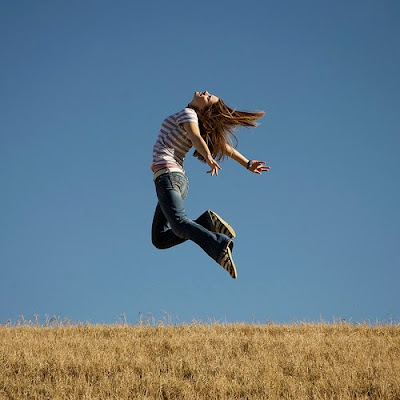However those are NOT Deadlifts.
In a deadlift you are only lifting the bar up approximately to your waist. Like in the image shown here on the right.
I think the confusion over the name of the particular weightlifting exercise is that a Deadlift sounds really difficult and people equate that with lifting the weight above your head. Except you are only lifting it about a third of that height.
When doing Deadlifts remember that form is very important so that you don't injure yourself. Stick to the prescribed Deadlift form and do it safely.
So pay attention as we journey down the road of brain and brawn and learn how to do a Proper Deadlift.
Step 1
Place the barbell on the ground and attach weights to it according to your strength and fitness level. If you are just starting out estimate the maximum amount you think you can lift and then lift half of that. (You can lift larger amounts later on once you've got the form correct.)
Step 2
Step up to the bar so that your feet are approximately shoulder width apart, the balls of your feet are under the bar, and your toes are pointing forward or slightly outward.
Step 3
Bend your knees while keeping your back straight, so that you look like you are in a sitting position.
Step 4
You should be close enough to reach the barbell, and grasp it with your hands slightly more than shoulder width apart, outside of your legs.
There are several different ways to grip the barbell. The most recommended style of gripping is the mixed grip (one palm facing you, one palm facing away), as it less likely to result in injuries, but use whichever grip feels the most comfortable.
For Olympic lifting, many people use the hook grip, which is more secure but is painful at first. It is similar to the overhand grip, except that instead of the thumb over the remaining fingers, it is hooked underneath them.
The underhand grip alone is not recommended because it can lead to the rupture of bicep muscle and connecting tendons, especially in people who do not have full flexibility in the elbow joint.
Step 5
Lower your hips so that your thighs are parallel to the floor. Keep the lower part of your legs mostly vertical. The angle between your foot and your lower leg should be close to 90 degrees.
The thighs should be parallel to the ground, but the back is not straightened yet.
Straighten your back and look straight ahead. Never lose the natural arch of your back.
Step 7
Lift the bar. Stand up by raising your hips and shoulders at the same rate and maintaining a flat back. Keep your abs tight during the whole lift. You should lift the bar straight up vertically and close to your body. Try thinking of it as pushing the floor away from you. Come to a standing position with upright posture and your shoulders pulled back. Allow the bar to hang in front of your hips. DO NOT try to lift it any higher.
Step 8
Lower the bar. Keeping your back straight, return the bar to the starting position in a controlled manner. Pushing your butt out as if you are going to sit down in a chair, and keep your head up. DO NOT drop the bar.
There, you've done it.
SAFETY NOTE! Avoid doing 6 or more deadlifts at a time. The more deadlifts you do the more likely you are to use improper form because you are rushing and overdoing it - which leads to injuries. Stick to 5 reps or less and stick to proper form.
And before you think for an instant that you cannot do this very simple weightlifting exercise try watching the following video of a little girl who is a weightlifting champion.
Once you've mastered Deadlifts (remember that form is very important for performing that exercise properly and without injury) you may also wish to try the following types of Deadlifts.
Romanian or Stiff Leg Deadlifts
These deadlifts are hips dominant. The exercise is a great core strengthener and also tones the glutes and hamstrings. It targets the lower back quite a bit to strengthen it.
1. Use very little weight while practicing this type of exercise until you get used to it. If you try to lift a lot more you will hurt your lower back.
2. While performing Romanian deadlifts keep your hips so far back that your toes start to rise as the weight is lowered. Think 98% weight on the heels, 2% in the toes for balance.
3. Bending your legs only a little lift the bar using an overhand (pronated grip). Your lower back will be doing most of the work so you will feel it there.
4. Stand tall and hold the bar or dumbbells with arms straight down at your thighs.
5. Keep the head up, shoulders back, knees slightly bent, and low back arched as the bar is lowered to the floor.
6. Repeat multiple times. If at any point you start to feel back pain cease lifting. (If you experience back pain a lot while doing this exercise you need to switch to a lower weight.)
One Leg Romanian Deadlifts
1. Exact same form as the Romanian lift except now you're on one foot with the other leg behind. Use either a dumbbell or barbell. If using a dumbbell attempt to hold it in the opposite hand of the working leg.
2. With this exercise try to do one rep holding the weight, place the weight on the floor, and perform the next rep empty-handed. This is for an extra challenge using co-ordination and balance.
3. Alternate hands and feet regularly.
































































